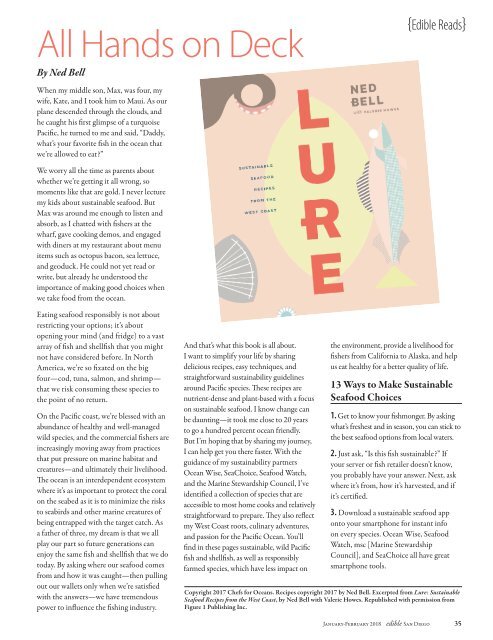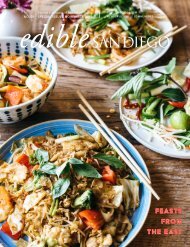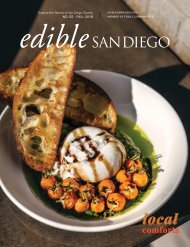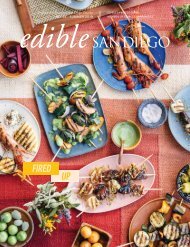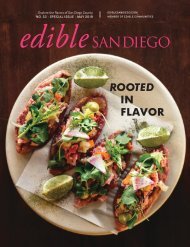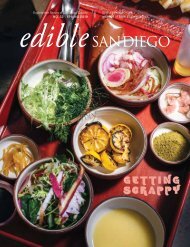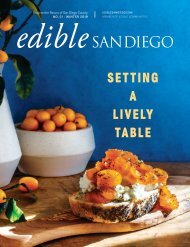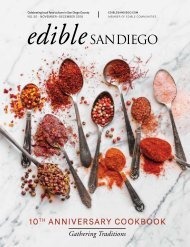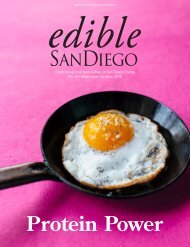Edible San Diego Issue 45 January/February 2018
E-edition of Edible San Diego Issue 45 January/February 2018
E-edition of Edible San Diego Issue 45 January/February 2018
You also want an ePaper? Increase the reach of your titles
YUMPU automatically turns print PDFs into web optimized ePapers that Google loves.
All Hands on Deck<br />
By Ned Bell<br />
{<strong>Edible</strong> Reads}<br />
When my middle son, Max, was four, my<br />
wife, Kate, and I took him to Maui. As our<br />
plane descended through the clouds, and<br />
he caught his first glimpse of a turquoise<br />
Pacific, he turned to me and said, “Daddy,<br />
what’s your favorite fish in the ocean that<br />
we’re allowed to eat?”<br />
We worry all the time as parents about<br />
whether we’re getting it all wrong, so<br />
moments like that are gold. I never lecture<br />
my kids about sustainable seafood. But<br />
Max was around me enough to listen and<br />
absorb, as I chatted with fishers at the<br />
wharf, gave cooking demos, and engaged<br />
with diners at my restaurant about menu<br />
items such as octopus bacon, sea lettuce,<br />
and geoduck. He could not yet read or<br />
write, but already he understood the<br />
importance of making good choices when<br />
we take food from the ocean.<br />
Eating seafood responsibly is not about<br />
restricting your options; it’s about<br />
opening your mind (and fridge) to a vast<br />
array of fish and shellfish that you might<br />
not have considered before. In North<br />
America, we’re so fixated on the big<br />
four—cod, tuna, salmon, and shrimp—<br />
that we risk consuming these species to<br />
the point of no return.<br />
On the Pacific coast, we’re blessed with an<br />
abundance of healthy and well-managed<br />
wild species, and the commercial fishers are<br />
increasingly moving away from practices<br />
that put pressure on marine habitat and<br />
creatures—and ultimately their livelihood.<br />
The ocean is an interdependent ecosystem<br />
where it’s as important to protect the coral<br />
on the seabed as it is to minimize the risks<br />
to seabirds and other marine creatures of<br />
being entrapped with the target catch. As<br />
a father of three, my dream is that we all<br />
play our part so future generations can<br />
enjoy the same fish and shellfish that we do<br />
today. By asking where our seafood comes<br />
from and how it was caught—then pulling<br />
out our wallets only when we’re satisfied<br />
with the answers—we have tremendous<br />
power to influence the fishing industry.<br />
And that’s what this book is all about.<br />
I want to simplify your life by sharing<br />
delicious recipes, easy techniques, and<br />
straightforward sustainability guidelines<br />
around Pacific species. These recipes are<br />
nutrient-dense and plant-based with a focus<br />
on sustainable seafood. I know change can<br />
be daunting—it took me close to 20 years<br />
to go a hundred percent ocean friendly.<br />
But I’m hoping that by sharing my journey,<br />
I can help get you there faster. With the<br />
guidance of my sustainability partners<br />
Ocean Wise, SeaChoice, Seafood Watch,<br />
and the Marine Stewardship Council, I’ve<br />
identified a collection of species that are<br />
accessible to most home cooks and relatively<br />
straightforward to prepare. They also reflect<br />
my West Coast roots, culinary adventures,<br />
and passion for the Pacific Ocean. You’ll<br />
find in these pages sustainable, wild Pacific<br />
fish and shellfish, as well as responsibly<br />
farmed species, which have less impact on<br />
the environment, provide a livelihood for<br />
fishers from California to Alaska, and help<br />
us eat healthy for a better quality of life.<br />
13 Ways to Make Sustainable<br />
Seafood Choices<br />
1. Get to know your fishmonger. By asking<br />
what’s freshest and in season, you can stick to<br />
the best seafood options from local waters.<br />
2. Just ask, “Is this fish sustainable?” If<br />
your server or fish retailer doesn’t know,<br />
you probably have your answer. Next, ask<br />
where it’s from, how it’s harvested, and if<br />
it’s certified.<br />
3. Download a sustainable seafood app<br />
onto your smartphone for instant info<br />
on every species. Ocean Wise, Seafood<br />
Watch, msc [Marine Stewardship<br />
Council], and SeaChoice all have great<br />
smartphone tools.<br />
Copyright 2017 Chefs for Oceans. Recipes copyright 2017 by Ned Bell. Excerpted from Lure: Sustainable<br />
Seafood Recipes from the West Coast, by Ned Bell with Valerie Howes. Republished with permission from<br />
Figure 1 Publishing Inc.<br />
<strong>January</strong>-<strong>February</strong> <strong>2018</strong> edible <strong>San</strong> <strong>Diego</strong> 35


